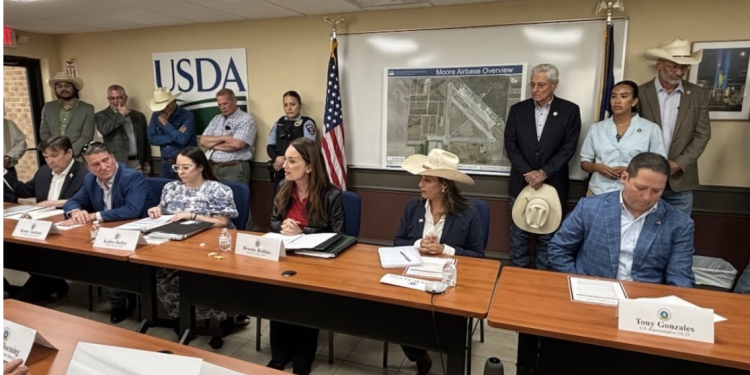EDINBURG, TX — U.S. Secretary of Agriculture Brooke L. Rollins unveiled a bold, $8.5 million strategy this morning to combat the potential northward spread of the New World Screwworm (NWS) by breaking ground on a sterile fly dispersal facility at Moore Air Base in South Texas and announcing a comprehensive five-pronged plan to protect U.S. livestock, wildlife, and food supply chains.
The NWS parasite, long eradicated from the United States, has resurfaced in southern Mexico, triggering an emergency response. In May, USDA halted all imports of live cattle, horses, and bison through southern border ports following detections of the pest in Oaxaca and Veracruz, approximately 700 miles from the U.S. border.
“The United States has defeated NWS before, and we will do it again,” said Secretary Rollins. “We will use every tool at our disposal to protect our livestock industry and food supply chain.”
A Five-Pronged National Defense Strategy
The USDA’s newly announced Five-Pronged Plan focuses on containment, eradication, preparedness, and innovation:
- Containment in Mexico
-
-
- USDA invested $21 million to expand sterile fly production in Metapa, Mexico.
- The combined sterile fly output from Mexico and Panama is expected to exceed 160 million flies per week.
- The agency is increasing surveillance and providing technical support to Mexico’s animal health authorities.
-
- Fortifying the U.S.-Mexico Border
-
-
- Enhanced surveillance, trap deployment, and public education campaigns will establish a “barrier zone of vigilance.”
- USDA will coordinate with U.S. Customs and Border Protection and local partners to intercept stray or illegal livestock.
- Maximizing Domestic Readiness
- USDA will collaborate with state agencies to update emergency plans and train first responders.
- Additional treatment supplies and streamlined federal regulations will ensure swift response capabilities.
- Establishing a Domestic Frontline
- The new sterile fly dispersal facility at Moore Air Base is expected to be operational by the end of 2025.
- USDA is exploring a U.S.-based sterile fly production site that could produce up to 300 million sterile flies weekly, supplementing efforts in Mexico and Panama.
-
- Innovating Eradication Technologies
-
- Research is underway to improve traps, lures, and fly sterilization methods.
- USDA is partnering with land-grant universities in Texas, Arizona, and New Mexico to expand local surveillance and outreach.
Texas Officials Voice Strong Support
Texas leaders, agricultural organizations, and federal representatives praised the USDA’s aggressive approach and renewed commitment to fighting the threat.
“Texas is on the front lines,” said Governor Greg Abbott, “and proactive measures like this facility are key to safeguarding our farming and ranching communities.”
Rep. Monica De La Cruz (R-TX) called the project “a critical facility in Hidalgo County,” thanking Secretary Rollins for her swift response to her proposal.
Rep. Tony Gonzales, author of the STOP Screwworms Act and a key advocate for funding, celebrated the facility’s groundbreaking as a “huge step forward.”
Rep. Vicente Gonzalez warned of economic risks if the pest spreads: “It must be eradicated. This facility is vital for South Texas.”
Rep. Ronny Jackson, whose district includes major cattle operations, said the USDA’s action ensures “every necessary tool” is available to ranchers.
Industry Applauds Science-Driven Strategy
Agricultural leaders expressed strong approval of the new measures:
- Sid Miller, Texas Commissioner of Agriculture, pledged state cooperation and said Texas “is prepared to assist in protecting our economy and food supply.”
- Senator John Cornyn called the plan “a significant step in the right direction,” pointing to the sterile fly production as essential.
- National Cattlemen’s Beef Association President Buck Wehrbein noted the Moore Air Base’s historical role in NWS eradication and praised the renewed investment.
- Texas Farm Bureau President Russell Boening labeled the new facility a “critical step” and applauded the USDA’s proactive leadership.
- Texas Cattle Feeders Association Chair Laphe LaRoe emphasized the importance of combined surveillance, treatment, and sterile fly distribution.
- Stephen Diebel, First Vice President of the Texas & Southwestern Cattle Raisers Association, said the announcement affirms Rollins’ promise to increase U.S. sterile fly capacity.
Looking Ahead
USDA will host four national listening sessions to gather stakeholder input on sterile fly technologies, eradication tools, and domestic versus international production capabilities.
For more information and access to USDA’s Five-Pronged Plan (PDF), visit:
🔗 usda.gov/screwworm-response (example link)
As Secretary Rollins stated during her remarks:
“We have the tools, the partnerships, and the grit. Now, we have the plan to finish this fight.”




